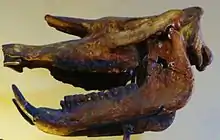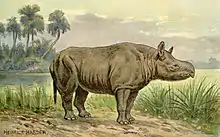Aceratherium
Aceratherium was a genus of rhinoceros of the subfamily Aceratheriinae that lived in Eurasia and Africa during the Miocene. It reached 2.3 m (7 ft 7 in) in length, a height of about 120 cm (47 in) and a weight of nearly 1 ton.[2]
| Aceratherium | |
|---|---|
 | |
| A. incisivum skull | |
| Scientific classification | |
| Kingdom: | Animalia |
| Phylum: | Chordata |
| Class: | Mammalia |
| Order: | Perissodactyla |
| Family: | Rhinocerotidae |
| Subfamily: | †Aceratheriinae |
| Genus: | †Aceratherium Kaup, 1832 |
| Species | |
Taxonomy

Aceratherium was coined by Kaup (1832) for "Rhinoceros" incisivum Cuvier, 1822 on the basis of the similarity of two skulls from Eppelsheim, Germany to the holotype incisor tooth from Weisenau in dental structure.[3] However, the tooth from Weisenau has been recognized as belonging to a member of Teleoceratini, although the name Aceratherium has been widely used for the Eppelsheim skulls.[4] Many species have been referred to Aceratherium, but only three valid species are recognized (A. incisivum, A. depereti, and A. porpani).
References
- Tao Deng; Rattanaphorn Hanta & Pratueng Jintasakul (2013). "A new species of Aceratherium (Rhinocerotidae, Perissodactyla) from the late Miocene of Nakhon Ratchasima, northeastern Thailand". Journal of Vertebrate Paleontology. 33 (4): 977–985. doi:10.1080/02724634.2013.748058.
- Esperanza Cerdeño and Begoña Sánchez: Intraspecific variation and evolutionary trends of Alicornops simorrense (Rhinocerotidae) in Spain. The Norwegian Academy of Science and Letters Zoologica Scripta 29 (4. October), 2000, p. 275–305
- Kaup J. J. (1832). "Über Rhinoceros incisivus Cuvier und eine neue Art, Rhinoceros schleiermacheri" [Concerning Rhinoceros incisivus Cuvier and a new species, Rhinoceros schleiermacheri]. Isis von Oken (in German). 8: 898–904.
- Giaourtsakis, I. X., and K. Heissig. 2004. On the nomenclatural status of Aceratherium incisivum (Rhinocerotidae, Mammalia); pp. 314–317 in A. A. Chatzipetros and S. B. Pavlides (eds.), Proceedings of 5th International Symposium on Eastern Mediterranean Geology, Volume1, 14–20 April 2004, Thessaloniki, Greece. Aristotle University, Thessaloniki.